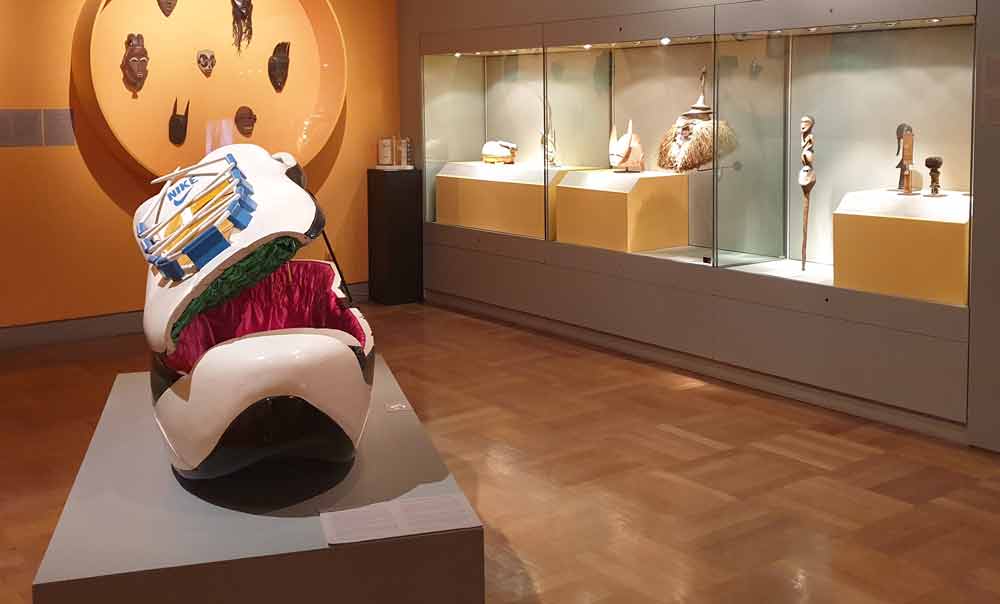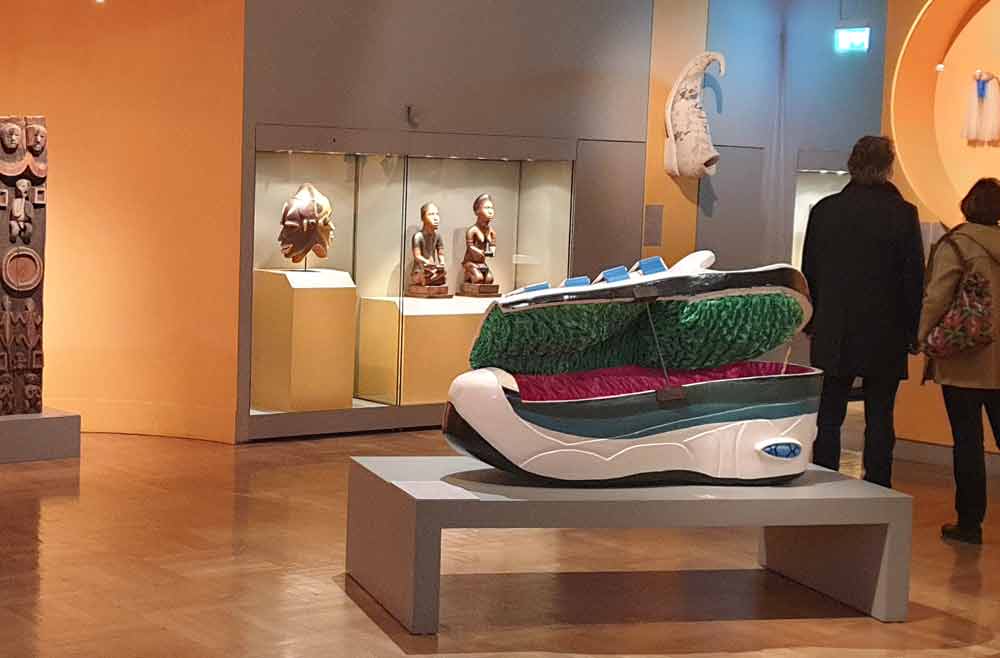Collections, Collisions, Connections
by Selasi Awusi Sosu
Since the unfortunate and untimely death of my dear mother in 2012, I have found myself on a number of occasions, pondering about the thin line between life and death. As an artist, the fantasy coffins of internationally renowned artists like Kane Kwei and Paa Joe have fascinated my students and me in Ghana. They have been the reason for class excursions from Winneba to Accra.
Seeing the "Nike Coffin" in the Museum Fünf Kontinente in Munich brought many worlds together in my mind! Ghana, Germany (and their cultures of preservation); life, death (and rituals of celebrating them). The paradoxes that are embedded in all of this leaped at me as I beheld the "Nike Coffin" made by the renowned Ghanaian artist Paa Joe on European soil. The daughter of a disciplinarian head teacher and a teacher herself, my late mother's simple oak coffin contrasts Paa Joe´s exaggerated "Nike Coffin". Yet, they're both united by the eternal fact of death.
I recollect the extraordinary encounter of Dr. Stefan Eisenhofer as he was in Nigeria, genuinely collecting African art to educate the world! As Dr. Eisenhofer explained, it was a near-death personal experience in the line of duty, which thankfully later on culminated in a "friendly" and calming exchange with his captor on the subject of soccer and later on art.
So, Ghana, Germany, soccer, art, life and death and more, were all mashed up in my mind on my first visit to the home town of the famous Bayern Munich soccer team, on an "Exploring Visual Cultures" project trip for art education.
published January 2021

Presentation of Paa Joe's coffin in the Museum Fünf Kontinente Munich, 2022 (Photo Ernst Wagner)
A Ghanian Nike coffin in a German museum
By Ernst Wagner
The Nike coffin in the shape of a sneaker was created in 2015 by the coffin maker Paa Joe in Ghana. The shape and logo of the well-known sportswear manufacturer, as well as the shoe size indication 42 in the footbed, give the object its title. Having 72 cm x 57 cm x 155 cm, it seems to be too small for a real coffin – it was probably made for the global art market.[1] It is made of wood, painted with lacquer colors. The inside is covered with shiny fabrics. Since 2016, the coffin has been on display in the Museum Fünf Kontinente in Munich, Germany. It is centrally located in the first room after the entrance to the permanent exhibition “Sub-Saharan Africa”.
Coffin burials were uncommon among the Ga (an ethnic group mainly in southern Ghana) for a long time. Rather, the dead were buried in mats and cloths and buried directly at the dwelling (Tschumi 2012:57). Against this tradition, Christian missionaries had tried to introduce the wooden coffin as part of Christian burial – now also in a cemetery – as early as the 18th century. After the Ghanaian coast became a British crown colony in 1874, the English finally banned traditional forms of burial in 1888 – against the resistance of large parts of the native population. A wooden coffin in Greater Accra is therefore initially a colonial product, with the help of which local tradition was to be suppressed.
However, about 60 years later, at the time of Ghana's independence in 1957, local carpenters began combining the simple Christian coffin with traditional figurative sedan chairs of local dignitaries.[2] (Such dignitaries are to be understood in the continuity of pre-colonial political structures – i.e. outside the colonial order. They still play an important role today.) Christian Ghanaians initially rejected such figurative coffins, Yet, a large-scale production developed. Masters and workshops got known throughout the country. Since then, Christian ceremonies could be distinguished from non-Christian ones. “Most Christian churches reject the use of figurative coffins as a ‘pagan’ custom. If they are used by Christians today, then only symbols that are not associated with the faith can be used.” (Tschumi 2012:59) This coffin here, which thematizes the passion for sports of a fictitious dead person, is a typical example of such a compromise.
In 1989, in the exhibition “Les Magiciens de la terre” in Paris, the French curator Hubert Martin exhibited such coffins for the first time in Europe. This enabled the Western art audience, influenced by American Pop Art, to appreciate these objects. Thus, coffins quickly found their way into collections in the Global North. Obviously they met an expectation of a connection between local African tradition and contemporary Western art at that time.
This in turn meant that it became lucrative for the coffin carpenters to also produce for the art market of the Global North. So they served both markets. This coffin, by the carver Paa Joe, who became famous through the exhibition “Les Magiciens de la terre”, was purchased by the Museum Fünf Kontinente in Munich in 2016.

Presentation of Paa Joe's coffin in the Museum Fünf Kontinente Munich, 2022 (Photo Ernst Wagner)
But what is the intention of European or American museums when they buy and exhibit such objects? And how should visitors react to them? Fascination, amusement or irritation? After all, what are these objects anyway, are they coffins or works of art? On the one hand they are coffins because they were made by coffin carpenters and because they would meet all aesthetic and functional requirements in their local context. But, in the context of Western art, they could also be ‘Readymades’ (a la Duchamp) … if they had not been made specifically for the art market and if it had not been the curators (and not the artists) who put the objects into the museum. Perhaps it is this categorical uncertainty, for which modern art is always good, that makes these (non-)coffins compatible with the global art system.
As such, however, they can tell the exciting story of intercultural interactions: colonial rulers introduced the practice of burying the dead in wooden coffins to West Africa, enforcing it against local resistance by means of Christianization and power. When, in the context of independence, local coffin makers creatively appropriated these imposed wooden coffins by combining them with local traditions, it was the Christian churches (brought into the country by the colonial rulers) that now resisted this “pagan nuisance”. Between the respective ideological positions, a creative practice developed, reminiscent of Pop Art, which is presumably why it is being discovered by curators from the Global North. Thus, such coffins ended up in European exhibitions, resulting in a hybrid product – created specifically for the Western art market. In this last phase, there is (at least so far) no visible resistance.
In the context of Western museums (there are no such coffins e.g. in the museum in Accra), these coffins become ambassadors of a new image of Africa: shaped by a self-confident, from a Western point of view, bold transformation of imagery with the help of current, global or local motifs – within traditional carving in the local context. On the other hand, a deeper study of the coffins and their contexts in West Africa gives visitors to Western museums insights into a different way of dealing with death, which may relativize their own views.
Stefan Eisenhofer, curator at the Museum Fünf Kontinente, who initiated the purchase of this coffin and is responsible for its presentation, says: “The coffin in the shape of a sports shoe is so exciting because on the one hand it looks familiar, but then it is confusing. And it addresses a fundamental human theme, the way we deal with life and death. In the exhibition itself, it is a great enrichment, an eye-catcher that can immediately inspire reflection. The so-called traditional African sculptures often mean little to visitors without prior information, but this coffin is quite different.” (Oral communication 18.2.2025)
Beyond that, the coffin can tell a story of resistance and self-assertion, of appropriation and transformation. The result is a hybrid object that marks a very distinct position of African modernism, one that eludes Western categories: coffin or artwork? Local rite or global commodity aesthetic? Traditional woodcarving and high-tech painting.
Paa Joe (born Joseph Teteh-Aschong in 1947) began a ten-year apprenticeship with the coffin carver Kane Kwei (1925 [?]–1992) in 1962 at the age of fifteen. He himself was a master to younger carvers who have also become well known, such as Eric Kpakpo (born 1979). Paa Joe took part in the 1989 exhibition “Les Magiciens de la terre” in Paris and has since been represented at many exhibitions in the Global North. Today, alongside Paa Joe's workshop, which is very well known in the Western art world, there are new and established coffin workshops with young masters.
References
- Tschumi 2014: Regula Tschumi. Verborgene Kunst. Die figürlichen Sänften und Särge in Ghana. Bern (Till Schaap Edition)
- Tschumi 2012: Regula Tschumi. Totenbett für einen Lebenden. In: Eva Huttenlauch (Hrsg.). Another Anthology of Black Humor. Frankfurt (Museum für Moderne Kunst)
Footnotes
[1] See also https://youtu.be/F5MEKc5y14E
[2] Perhaps they were also inspired by ancient Egyptian coffins. The construction of lines of alignment in ancient Egypt was an important assertion of identity at the time of the independence movement.
published February 2025
